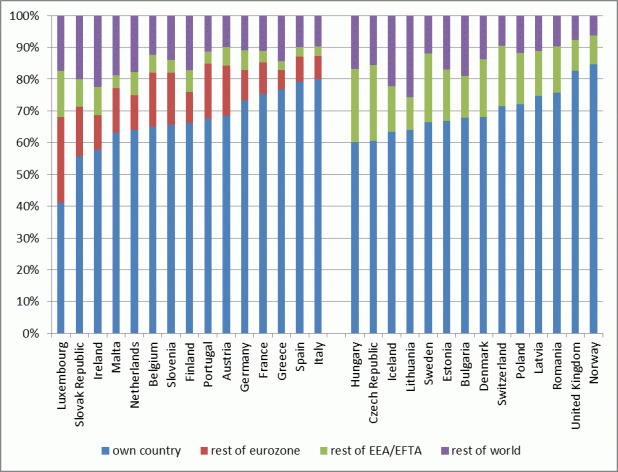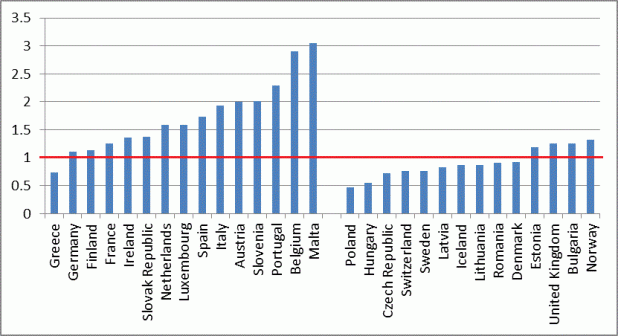Previous blogposts (here and here) have written approvingly of the trend to include more foreign-produced value added in a country’s exports. What this means is that the components and parts in a finished product (which includes contributions to a product’s value such as design and marketing) are increasingly being sourced from other countries, demonstrating how companies are looking further afield to find the best quality and competitiveness among their suppliers.
There is a strong inverse relationship between the proportion of foreign-produced value added in a country’s exports and its population, i.e. smaller countries export more foreign content, which is surely not surprising: a company in a large country is more likely to find what it needs at home. The relatively low proportion of foreign-produced value added in the exports of countries such as Greece and the UK is evidence of how their exporting companies are not integrated enough into and benefiting from international supply chains. If one values prosperity regardless of national borders, this is a pity.
One consequence of this form of trade integration is that companies become more vulnerable to variations in the exchange rate. It affects not only their exports but also their supply chain. Trading in a foreign currency is a cost – you have to convert from one currency to another – and also a risk – the exchange rate might change – which is itself a further cost. Knowing the value of your currency is valuable.

Origins of value added in the exports of EEA/EFTA countries (data OECD 2009)
The chart above shows how the countries in the eurozone, on the left, have been able to reduce the impact of currency instability on their supply chains by sharing a currency. The combined share of domestic value added (shown in blue) and that from the rest of the eurozone (shown in red) is notably higher than that for similarly-sized countries outside the eurozone.
A higher proportion of foreign-produced value added in a country’s exports also serves to make devaluation less effective as a policy tool. One of the conventional recommendations for countries facing financial crises is to devalue the currency: this will make exports cheaper and so more attractive in foreign markets. If, however, a large proportion of those exports is imported first before being re-exported, devaluation will have less effect, a phenomenon discussed previously on this website here. Countries with a relatively low proportion of domestic valued added in their exports therefore have to work harder to find other ways to reduce domestic costs.

Ratio of growth of exports of value added sourced in domestic currency vs sourced in foreign currencies, 1995 to 2009 (data OECD)
The graph above compares the rate of growth of value added sourced in the domestic currency compared with value added sourced in foreign currencies, between 1995 and 2009, a time period which includes the launch of the euro and the enlargement to EU to central and eastern Europe.
For the countries in the left hand group, trade with the rest of the eurozone switched from being in a foreign currency to a domestic currency (the euro), which explains why the export of value added sourced in the domestic currency has been so much more significant than for the non-eurozone countries on the right. Smaller countries such as Malta, Belgium and Portugal felt this effect to a greater extent than larger countries such as France and Germany.
Among the non-euro countries in the right hand group, Poland, Hungary and the Czech Republic saw very high growth in the export of foreign-sourced value added, as they joined the EU and their companies integrated themselves very rapidly into western European supply chains. The countries the furthest to the right of the non-eurozone group, whose exports of domestic value added grew faster than those of value added from foreign sources, effectively saw the eurozone integrate without them: Norway because of its oil exports; the UK because of the financial services industry that dominated its economy.
Lastly, we see that Greece was the only country in the euro to see its exports of non-euro-priced value added grow faster than its euro-priced exports. Here is another indication that Greece is an economic exception within the eurozone, failing to capitalise on the opportunities that euro membership offered.
The post How the euro protects its members appeared first on Federal Union.